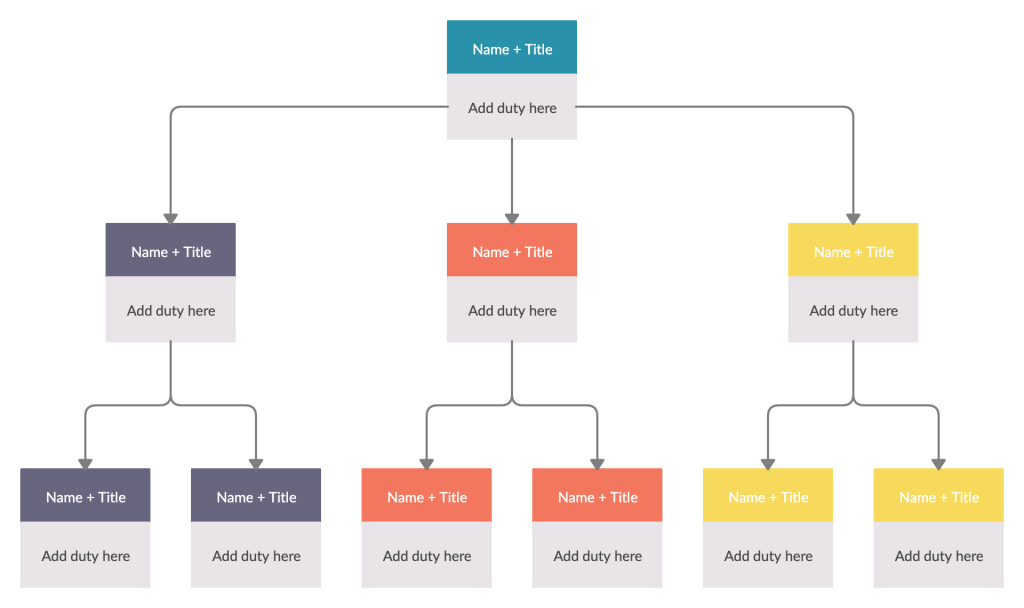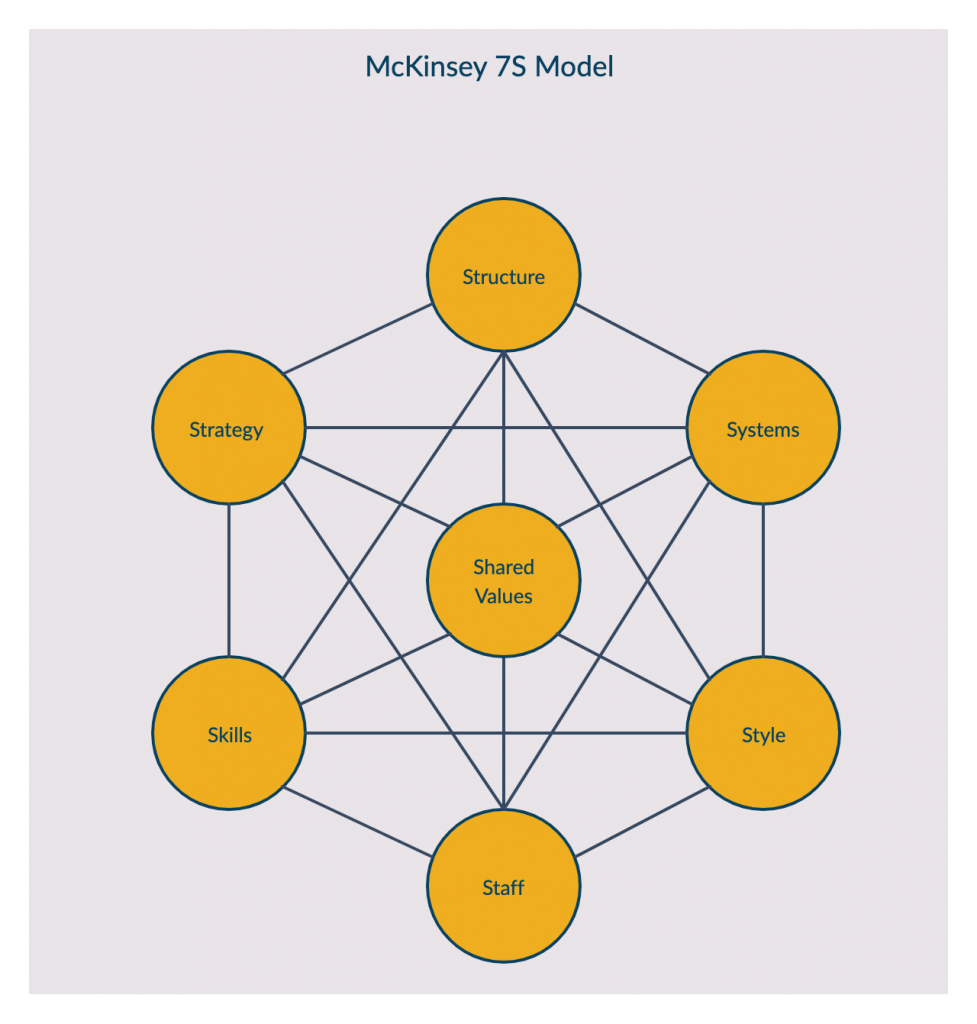Although invented in the late 1970s, the McKinsey 7S model still helps businesses of all sizes succeed. A conceptual framework to guide the execution of strategy.
In this guide, we’ll walk you through the 7S of the McKinsey Framework and how to apply it to evaluate and improve performance.
McKinsey 7-S Model Definition
The McKinsey 7S model is one of the most popular strategic planning tools. Businesses commonly use it to analyze internal elements that affect organizational success.
The model recognizes 7 of these elements and considers them to be interlinked, therefore it’s difficult to make significant progress in one area without making progress in other areas as well. Accordingly, to be successful, the organization should ensure that all these elements are aligned and reinforced.
The model divides these 7 elements into two categories;
Hard elements – Strategy, Structure, Systems (these are easier to be identified and defined and can be directly influenced by the management)
Soft elements – Shared Values, Skills, Style, Staff (these are harder to be defined because they are less tangible, but are just as important as the hard elements)
You can use the framework
- To successfully execute new strategies
- To analyze how different key parts of your organization work together
- To facilitate changes in the organization
- To help align processes during a merger or acquisition
- To support management thinking during strategy implementation and change management
The 7 Elements of the McKinsey 7-S Framework
- Strategy
- Structure
- Systems
- Skills
- Staff
- Style
- Shared values
Let’s dig into these elements in more detail.
Strategy
A strategy is a plan the company develops to maintain its competitive advantage in the market. It consists of a set of decisions and action steps that need to be taken in response to the changes in the company’s external environment which includes its customers and competitors.
An effective strategy would find external opportunities and develop the necessary resources and capabilities to convert the environmental changes into sources of new competitive advantage.
Structure
The structure is the organizational chart of the company. It represents how the different units and divisions of the company are organized, who reports to whom and the division and integration of tasks. The structure of a company could be hierarchical or flat, centralized or decentralized, autonomous or outsourced, or specialized or integrated. Compared to most other elements, this one is more visible and easier to change.

Systems
These are the primary and secondary activities that are part of the company’s daily functioning. Systems include core processes such as product development and support activities such as human resources or accounting.
Skills
Skills are the skill set and capabilities of the organization’s human resources. Core competencies or skills of employees are intangible but they a major role in attaining sustainable competitive advantage.
Staff
The most valuable strategic asset of an organization is its staff or human resources. This element focuses on the number of employees, recruitment, development of employees, remuneration and other motivational considerations.
Style
This refers to the management style of the company leadership. It includes the actions they take, the way they behave, and how they interact.
Shared Values
Shared values are also referred to as superordinate goals and are the element that is in the core of the model. It is the collective value system that is central to the organizational culture and represents the company’s standards and norms, attitudes, and beliefs. It’s regarded as the organization’s most fundamental building block that provides a foundation for the other six elements.

How to Use the McKinsey 7-S Model
The model can be used to do a gap analysis or to determine the gap between what the company is currently doing and what it needs to do to successfully execute the strategy.
Step 1: Analyze the current situation of your organization
This is where you need to understand the current situation of the organization with regard to the 7 elements. Analyzing them closely will give you a chance to see if they are aligned effectively.
The following checklist questions will help you explore your situation.
Strategy
- What’s the objective of your company strategy?
- How do you use your resources and capabilities to achieve that?
- What makes you stand out from your competitors?
- How do you compete in the market?
- How do you plan to adapt in the face of changing market conditions?
Structure
- What’s your organizational structure?
- Who makes the decisions? Who reports to whom?
- Is decision-making centralized or decentralized?
- How do the employees align themselves to the strategy?
- How is information shared across the organization?
Sytems
- What are the primary processes and systems of the organization?
- What are the system controls and where are they?
- How do you track progress?
- What are the processes and rules the team sticks with to keep on track?
Skills
- What are the core competencies of the organization? Are these skills sufficiently available?
- Are there any skill gaps?
- Are the employees aptly skilled to do their job?
- What do you do to monitor, evaluate and improve skills?
- What is it that the company is known for doing well?
Staff
- How many employees are there?
- What are the current staffing requirements?
- Are there any gaps in the required resources?
- What needs to be done to address them?
Style
- What is the management style like?
- How do the employees respond to this style?
- Are employees competitive, collaborative or cooperative?
- What kind of tasks, behaviors, and deliverables does the leadership reward?
- What kind of teams are there in the organization? Are there real teams or are they just nominal groups?
Shared Values
- What are the mission and vision of the organization?
- What are your ideal and real values?
- What are the core values the organization was founded upon?
- How does the company incorporate these values in daily life?
Step 2: Determine the ideal situation of the organization
Specify where you ideally want to be and the optimal organizational design you want to achieve, with the help of the senior management. This will make it easier to set your goals and come up with a solid action plan to implement the strategy.
Since the optimal position you want to be in is still not known to you, you will have to collect data and insight through research on the organizational designs of competitors and how they coped with organizational change. Answering the questions above are just the starting point.
To understand what your organization is best at, use the Hedgehog Concept by Jim Collins
Step 3: Develop your action plan
Here you will identify which areas need to be realigned and how you would do that. The result of this step should be a detailed action plan listing the individual steps you need to take to get to your desired situation, along with other important details such as task owners, timeframes, precautions and so on.

Step 4: Implement the action plan
Successfully executing the action plan is depended on who executes it. Therefore you need to make sure that you assign the tasks to the right people in your organization. Additionally, you can also hire consultants to guide the process.
Step 5: Review the seven elements from time to time
Since the seven elements are subjected to constant change, reviewing them periodically is essential. A change in one element will affect all the others, which will require you to implement a new organization design. Review the situation frequently to stay aware of the remedial action you might want to take.
Advantages and Disadvantages of McKinsey 7-S Model
Advantages
- Considers 7 elements of strategic fit, which is more effective than the traditional model that only focuses on strategy and structure
- It helps align the processes, systems, people, and values of an organization
- Since it analyzes each element and the relationship between them in detail, it ensures that you miss no gaps caused by changed strategies
- Helps organizations identify how they should align the different key parts of the organization to achieve their goals
Disadvantages
- It requires the organization to do a lot of research and benchmarking, which makes it time-consuming
- It only focuses on internal elements, while paying no attention to the external elements that may affect organizational performance.
- It requires the help of senior management which may not be readily available depending on how busy they are
To analyze and understand the performance or the functioning of the organization use Weisboard’s six box model framework.
What’s Your Take on the McKinsey 7-S Model?
The McKinsey 7S model is a proven framework for helping organizations understand how to get from their current situation to the situation they prefer to be in.
Maybe you are a big fan of the McKinsey 7S model. Maybe you prefer another strategy framework that has worked well for you. We’d love to hear what you feel about the subject; give your feedback in the comments section below.





